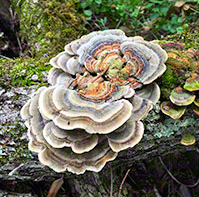Mushrooms and Mycelium Help the Microbiome

Few people know that we are more closely related to fungi than to any other kingdom. 650 million years ago, we split from fungi. We evolved to encircle our nutrients within a cellular sack, a stomach, and digested nutrients within. Fungi evolved to externally digest its nutrients, and projected a fine filamentous, cobweb like cellular networks known as mycelium. In both cases, over millions of years, choosing beneficial bacteria to aid in this process became essential for good digestion. By selecting commensal bacteria to help digest food, both humans and mushroom mycelium created complex communities -- microbiomes -- to help digestion, prevent disease, and extend longevity. Not only do we benefit from a healthy microbiome, but so too does the mycelium.
The mushroom is a fruit of the mycelium, like an apple is to an apple tree. Mushrooms are made of compacted mycelium but are materially different than mycelium. Mushrooms are nutritionally dense, packed with polysaccharides, proteins, minerals, vitamins (B, D), are low in fat (5%, mostly linoleic acids) and are free of cholesterol. The cobwebby mycelium exudes enormous suites of enzymes, antimicrobial agents, antiviral compounds, as it grows in the ground beneath our feet and in the forests around us. Mycelium is the cellular foundation of our food webs, creating the rich soils so necessary for life. Mycelium is a digestive membrane that also destroys many environmental toxic wastes, and has spawned a new science -- called "Mycoremediation." Promoting mycelium in your garden and yards helps neutralizes many of the toxins that challenge our immune systems. Partnering with mycelium improves environmental health -- outside and inside our body
Mycelium's selection of bacteria, in the creation of guilds of microbes, is essential for the mycelium's survival. The mycelium chooses suites of bacteria that not only helps it digest food, and stave off predators, but also helps the plant communities that give rise to the ecosystems in which the mycelium resides, so fruits (mushrooms) can be produced. This means that mycelium based products can aid digestion and help promote beneficial bacteria in our microbiomes.
The nutritious and delectable mushrooms are very temporary, typically up only for a few days, attracting us and many other animals. Of great interest is that we know now mushrooms are prebiotics for the micrbiome -- augmenting the growth of beneficial bacteria such as Acidophilus and Bifidobacterium. Recent research now shows the consumption of Reishi and Turkey Tail mushrooms, not only support the immune system, but also balance the microbiome in favor of these beneficial bacteria, resulting in better digestion, and, amazingly, potential weight loss!
Consuming mushrooms and mycelium adds many benefits in our pursuit of good health. Just make sure the products you consume are Certified Organic, US grown (better inspections), and that you know where they are grown and who is growing them. This is so important because there is a lot of deceptive advertising motivated by maximizing profits by minimizing costs, which jeopardizes quality. Adding mushrooms to your diet is probably one of the most important additions to the foods you can ingest that will improve your health!
References
On Opisthokonta. https://en.wikipedia.org/wiki/Opisthokont
Kumar Pallav, Scot E Dowd, Javier Villafuerte, XiaotongYang, Toufic Kabbani, Joshua Hansen, Melinda Dennis,
Daniel ALeffler, David S Newburg and Ciarán P Kelly. "Effects of polysaccharopeptide from Trametes versicolor and amoxicillin on the gut microbiome of healthy volunteers: A randomized clinical trial." Gut Microbes. 2014 Jul 1;5(4):458-67. http://www.tandfonline.com/doi/abs/10.4161/gmic.29558
Nathalie M. Delzenne & Laure B. Bindels. "Gut microbiota: Ganoderma lucidum, a new prebiotic agent to treat obesity?" Nature Reviews Gastroenterology & Hepatology. 12, 553–554 (2015). http://www.nature.com/nrgastro/journal/v12/n10/full/nrgastro.2015.137.html
Vanessa Moser. "The Human Microbiome: The Brain-Gut Axis and its Role in Immunity." Graduate Research Projects. Paper 7. 12-2014. http://knowledge.e.southern.edu/gradnursing/7
